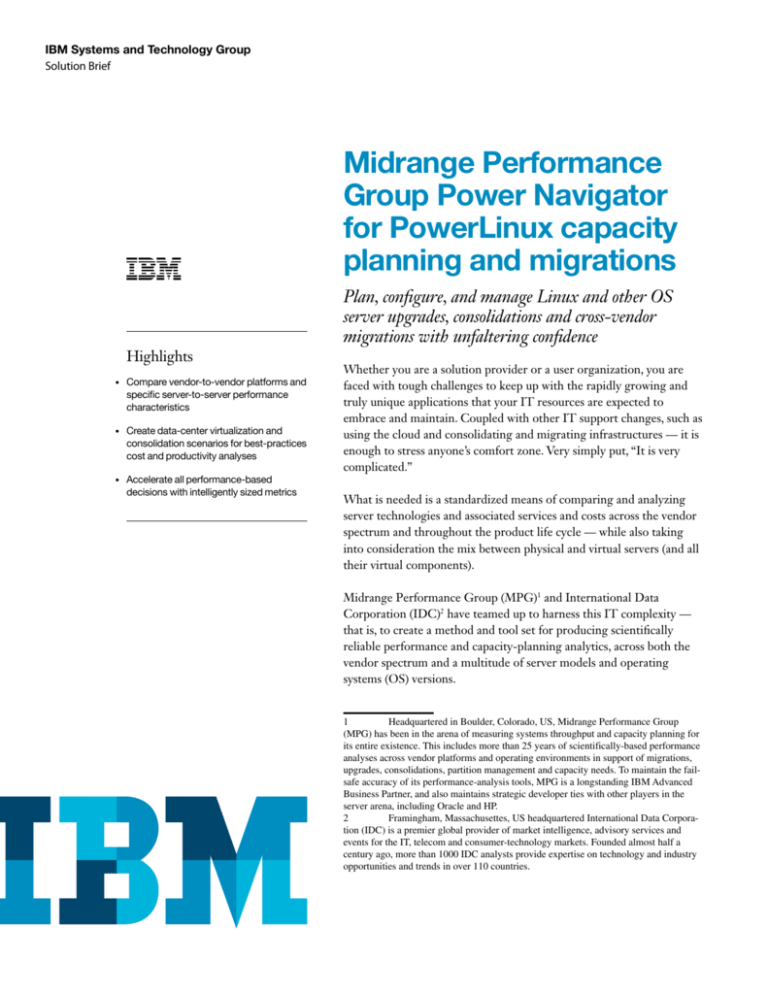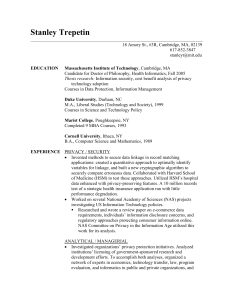
IBM Systems and Technology Group
Solution Brief
Midrange Performance
Group Power Navigator
for PowerLinux capacity
planning and migrations
Highlights
•
ompare vendor-to-vendor platforms and
C
specific server-to-server performance
characteristics
•
reate data-center virtualization and
C
consolidation scenarios for best-practices
cost and productivity analyses
•
ccelerate all performance-based
A
decisions with intelligently sized metrics
Plan, configure, and manage Linux and other OS
server upgrades, consolidations and cross-vendor
migrations with unfaltering confidence
Whether you are a solution provider or a user organization, you are
faced with tough challenges to keep up with the rapidly growing and
truly unique applications that your IT resources are expected to
embrace and maintain. Coupled with other IT support changes, such as
using the cloud and consolidating and migrating infrastructures — it is
enough to stress anyone’s comfort zone. Very simply put, “It is very
complicated.”
What is needed is a standardized means of comparing and analyzing
server technologies and associated services and costs across the vendor
spectrum and throughout the product life cycle — while also taking
into consideration the mix between physical and virtual servers (and all
their virtual components).
Midrange Performance Group (MPG)1 and International Data
Corporation (IDC)2 have teamed up to harness this IT complexity —
that is, to create a method and tool set for producing scientifically
reliable performance and capacity-planning analytics, across both the
vendor spectrum and a multitude of server models and operating
systems (OS) versions.
1
Headquartered in Boulder, Colorado, US, Midrange Performance Group
(MPG) has been in the arena of measuring systems throughput and capacity planning for
its entire existence. This includes more than 25 years of scientifically-based performance
analyses across vendor platforms and operating environments in support of migrations,
upgrades, consolidations, partition management and capacity needs. To maintain the failsafe accuracy of its performance-analysis tools, MPG is a longstanding IBM Advanced
Business Partner, and also maintains strategic developer ties with other players in the
server arena, including Oracle and HP.
2
Framingham, Massachusettes, US headquartered International Data Corporation (IDC) is a premier global provider of market intelligence, advisory services and
events for the IT, telecom and consumer-technology markets. Founded almost half a
century ago, more than 1000 IDC analysts provide expertise on technology and industry
opportunities and trends in over 110 countries.
IBM Systems and Technology Group
Solution Brief
Why is the IDC Qualified Performance Indicator (QPI)
important?
In 2011, Midrange Performance Group and IDC announced a
partnership that allows MPG to embed the IDC Qualified
Performance Indicator (QPI) into its Power Navigator product.
This provides the ability to model server workloads across
various manufacturers’ server platforms. This was needed
because performance is the most difficult to measure when
comparing servers of different ages, architectures and brands.
IDC provides a common means of measuring four key
attributes of a server system: performance, power consumption,
density, and cost. The QPI measurements provide values on
more than 20 000 individual server configurations spanning 15
years to support system sizing and buying decisions.
The resulting product is named Power Navigator part of the
MPG Navigator Family powered by IDC QPI. Your
organization can use MPG’s Power Navigator to make more
informed decisions while helping save time and money.
As mentioned, you can track the historical performance for an
almost exhaustive list of Linux® versions that are supported
by IBM® Power Systems™ and other UNIX® servers. With
the Capacity Planning feature, data that is collected from any
listed OS can be modeled to any server; you can also
consolidate servers and configure logical partitions to
determine optimal performance scenarios. (The IDC
Qualified Performance Indicator [QPI] is invaluable in this
process; see the QPI discussion in the adjacent side bar.) You
can use the Power Navigator on existing systems to
scientifically plan for a server consolidation, and then manage
the new system with the help of a comprehensive set of graphs
and reports.
More than 125 IBM Business Partners already use the MPG
Navigator Family as the preferred method of planning and
managing server upgrades and consolidations.
MPG is tightly focused on assisting these solution providers
who, in turn, need to advise their clients on the optimal
configuration for upgrades and vendor migrations — based on
the clients’ disparate workloads, operating environments and
historical performance parameters.
“Power Navigator accesses the organization’s
own data, collected by NMON, and uses
precise math modeling to provide an
impartial and highly accurate projection of
the size and capacity needed for the
destination server.”
– William (Randy) Watson,
President Midrange Performance Group
Peace of mind during migrations and
server consolidations
Platform migrations and server consolidations can be
particularly daunting. The huge number of mergers and
acquisitions in today’s competitive business environment
compels IT shops to plan for large-scale server consolidations
as well as platform changes from one server vendor to
another. Although these migrations might still involve the
same workloads, applications and operating system (such as
Linux or IBM AIX®), the complexity is still enormous.
Vendor migrations require a huge leap of faith for the IT
teams who are involved. Each OS, as well as its underlying
hardware, handle various processes in distinct ways internally,
which means that there are going to be variations in
performance (disk utilization, memory availability and
processor speed)3.
3
MPG Performance Manager provides performance-management,
problem-determination and capacity-planning tools for use specifically on the
IBM System i platform.
IBM Systems and Technology Group
Solution Brief
Power Navigator uses data collected from the users’ systems
by the NMON Collection Manager (which is included along
with Power Navigator) to produce conservative models of that
same workload performing on a specified IBM POWER®
processor-based server configuration.
Power Navigator is a math-modeling algorithm that also
incorporates published performance figures that are supplied
by IBM and other server vendors4, as well as the relevant IDC
QPI performance figures that have been normalized for the
purpose of comparing these platforms. Power Navigator
makes it possible to collect and access historical performance
and capacity data that is stored on the system to perform
comparisons for any time period that is relevant (days,
months, or even years).
What Power Navigator means for IBM
PowerLinux
Perhaps more than any other widely-used OS, Linux can be
challenging for those who need to predict its postmigration,
upgrade or consolidation performance. Linux is so easily
customizable and, therefore, there are so many versions of it
in the IT community. For example, there are more than 60
versions of Linux alone. That is why the QPI and other
performance indicators that are part of the Power Navigator
math-modeling algorithm are particularly important when
consolidating x86 Linux applications on PowerLinux.
4
•
•
•
For example, these performance figures include:
Commercial processing workload (CPW), a relative measure of performance of systems running the IBM i operating system
SPEC CPU2000, a compute-intensive performance measurement that is
portable across platforms
rPerf, the metric of relative performance for IBM Power servers
“Power Navigator not only recommends the
number of cores needed to support the
workload but recommends the IBM
PowerVM® configuration for each
partition.”
– Randy Watson
Why PowerLinux
Making the decision to run your Red Hat or Novell SUSE
Linux applications on PowerLinux servers brings exceptional
value to your Linux IT investments. The IBM Power Systems
family of IBM POWER7® processor-based systems is
designed to provide outstanding performance, availability,
scalability and dynamic-resource allocation. Unique IBM
virtualization features allow you to process more information
on a single server, creating the potential to save on total cost
of system ownership, as well as space and energy costs.
Equally important, both Red Hat and Novell SUSE Linux run
natively on Power Systems. IBM has worked to enable its
entire server and storage product line to interoperate with
Linux. This includes ensuring that Linux uses the unique
advantages and enhanced functions provided by IBM Systems.
IBM pioneered the use of Linux for mission-critical workloads
on Power Systems servers, while also ensuring that key
business application workloads and the IBM software family
run with the stability and efficiency demanded of IBM
Systems.
IBM delivers new PowerLinux solutions, optimized to deliver
high-value Linux services, and specifically designed to bring
the capabilities of POWER7 to customers of competitive x86.
IBM Watson is a prime example of optimized PowerLinux.
These solutions deliver Linux services faster, with higher
quality, and more economically than ever before.
“With one customer, the MPG analysis
showed that the customer would be able to
consolidate 23 images and 13 different
hardware x86 platforms onto one of IBM’s
PowerLinux servers.”
– Randy Watson
IBM delivers Linux focused technical expertise to customers
and solution providers through the Linux Integration Center.
This includes help with proof-of-concept implementations,
best practices and initial deployment, as well as enablement of
integrated software solutions on Linux. The IBM Linux
Integration Center can also help define and build the right
solution stack, including the hardware, operating system,
middleware, applications and tools.
For more information
To learn more about this Midrange Performance Group solution and IBM Power Systems running Linux, contact your
IBM marketing representative or Midrange Performance
Group, or visit the following websites:
ibm.com/partnerworld/wps/pub/overview/SOH1001 and
www.mpginc.com
© Copyright IBM Corporation 2012
IBM Corporation
IBM Systems and Technology Group
3039 Cornwallis Road
RTP, NC 27709
Produced in the United States of America
April 2012
All Rights Reserved
IBM, the IBM logo, and ibm.com, POWER, POWER7, PowerLinux,
Power Systems and PowerVM are trademarks or registered trademarks of
International Business Machines Corporation in the United States, other
countries, or both. If these and other IBM trademarked terms are marked
on their first occurrence in this information with a trademark symbol (®
or ™), these symbols indicate U.S. registered or common law trademarks
owned by IBM at the time this information was published. Such
trademarks may also be registered or common law trademarks in other
countries. A current list of IBM trademarks is available on the Web at
“Copyright and trademark information” at ibm.com/legal/copytrade.
shtml
PowerLinux™ uses the registered trademark Linux® pursuant to a
sublicense from LMI, the exclusive licensee of Linus Torvalds, owner of
the Linux® mark on a worldwide basis.
Linux is a registered trademark of Linus Torvalds in the United States,
other countries, or both.
UNIX is a registered trademark of The Open Group in the United States
and other countries.
Other product, company or service names may be trademarks or service
marks of others.
Any references in this information to non-IBM websites are provided for
convenience only and do not in any manner serve as an endorsement of
those websites. The materials at those websites are not part of the
materials for this IBM product and use of those websites is at your own
risk.
Please Recycle
XXX00000-USEN-00







